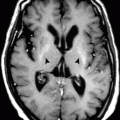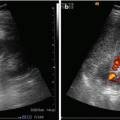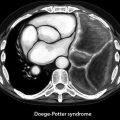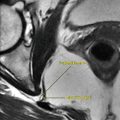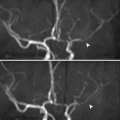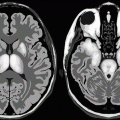(1)
Department of Clinical Radiology, Amiri Hospital – Kuwait City, Kuwait City, Kuwait
14.1 Microcurrent Therapy
Microcurrent therapy is a form of therapy that uses Galvanic, direct current (DC) with low amperage (<1000 μA) and low frequency (0.5–100 Hz) for healing purposes. Microcurrent therapy simply produces electrical signals like those naturally produced in the body during repair and healing process.
Electric current is defined as the flow of charged particles, mostly electrons. When the current flows in “one direction,” it is called direct current (DC). In contrast, when the flow is “back and forth,” it is called alternating current (AC). As a general rule, DC heals, while AC inhibits.
The human body works via DC electricity, which is in the range of pico-ampere (Trillionths), nano-ampere (Billionths), and micro-ampere (Millionths). DC microcurrents are essential part of any “healing process” in the body, according to the work of Robert O. Becker – a famous American orthopedic surgeon who is considered the father of electromedicine due to his famous work on salamanders – published in his book The Body Electric.
Microcurrent therapy follows the same physiological mechanisms of action as acupuncture and neural therapy after Huneke. Acupuncture and microcurrent healing follow the theory of Rudolf Arndt (1835–1900) and Hugo Schulz (1853–1932), also known as the Arndt–Schulz law, which states that weak electrical stimuli increase physiological activities and strong electrical stimuli inhibit physiological activities.
In 1965, Melzack and Wall described the “gait theory” of pain, which states that “Both sensory and pain signals are competing to access the brain via the spinal horn dorsal horns. Sensory neurons are faster than pain neurons, and when sensory neurons are activated, they will block the pain signals.” The gait theory resulted in the formation of “transcutaneous neurostimulation (TENS)” devices.
Basic Electrical Healing Physiology
Trauma and cellular injury manifest themselves as a dysfunction of the autonomic homeostasis. Most research data on pain management and therapy suggests that chronic pain originates from the autonomic nervous system.
It has been shown that injured areas are more electroconductive than the surrounding skin due to the formation of what is known as healing microcurrents. Therefore, any physical disorder which increases autonomic activity can be measured at specific points using a point-specific probe, which is the basis of many acupuncture-based diagnostic devices.
According to Jerry Tennant, an American ophthalmologist from Texas and a pioneer in the field of electric and quantum medicine, disorders can be viewed as lack of energy (voltage) or excess energy (voltage) within the injured tissue; correcting the electrical status of the injured tissue results in immediate pain relief.
Acute injuries generally cause the injured tissue to have a combination of abnormally high and abnormally low resistances. Basic physics teaches that electricity flows toward the path of least resistance. Therefore, endogenous bioelectricity avoids areas of high resistance (inflamed areas) and takes the easiest path, generally around the injured tissues. Robert O. Becker discovered through his studies on salamanders that healing takes place in the body via initiating “DC current” at the damaged tissues; he called them “healing biocurrents” (Fig. 14.1.1).


Fig. 14.1.1
An illustration that demonstrates the healing biocurrents
When there is damage to a tissue, the adenosine triphosphate (ATP) is reduced, impairing the cellular membrane sodium–potassium pump. The dysfunction cellular membrane and the localized edema increase the tissue’s electrical resistance compared to the normal tissues surrounding them. Moreover, an abnormal electrical current and magnetic field are created due to leakage of the intracellular ions and disruption of the sodium–potassium pump; this abnormal electrical current is known as the “current of injury,” and it is perceived as pain.
According to Jerry Tennant, in order to overcome this electrical resistance and initiate healing process, the surrounding tissues have to increase the “voltage” of the electrical current they supply to (−50 mV), so healing can be initiated. Without such voltage, the current produced will not be a constant DC, which is the basic current required for healing the tissues.
Microcurrent Therapy Benefits
Microcurrent therapy delivers a DC in the range of normal body healing DC, which is like an external intervention for the injured tissue. If constant DC with high voltage (−50 mV) is not supplied, the acute insult will progress into a chronic insult. In quantum medicine teachings, your drug is the “frequency” you send, and your vehicle of delivery is the “wave” (electrical, magnetic, ultrasonic, or photonic) (Fig. 14.1.2). Some of these waves match the waves produced by hormones and other metabolic messengers, which will initiate the normal cascade of cellular functions (similar to tuning a radio toward a specific channel). It is important to mention here that these waves have to be in a specific range; otherwise, the cells will not respond. The cellular endogenous reaction to external vibration (e.g., resonance) is “windowed” for biological systems like the endocrine, immune, and neural systems. This means that there is a frequency “window” or “range,” called Adey’s window, at which the effect occurs; below or above this window, no biological reaction will be seen. The established benefits of microcurrent therapy in the literature are summarized as follows:


Fig. 14.1.2
An illustration that demonstrates the quantum therapies and their mode of energy wave delivery
- 1.
It treats myofascial trigger points efficiently and easily.
- 2.
Microcurrent supplies electrons, which accelerate ATP production by 300–500 %.
- 3.
It boosts protein synthesis by 70 %.
- 4.
It accelerates healing of acute injuries by 200 %.
- 5.
It reduces inflammatory cytokines in the blood.
- 6.
It softens scars and swellings (will drain within minutes if the correct frequency is applied).
Microcurrent Therapy Healing Mechanisms
Microcurrents accelerate healing (work as a catalyst) via the following suggested mechanisms:
- 1.
Accelerate inflammatory response: in contrast to steroids and nonsteroidal anti-inflammatory drugs, which suppress inflammatory mediators, microcurrents accelerate the inflammatory response, which results in healing, since acute inflammatory response is part of healing. Acceleration of the acute inflammatory response presents the inflammatory reaction from going into sideways that can lead to prolongation of the inflammatory response leading to chronic inflammation.
- 2.
The tsunami effect: microcurrents applied to the tissues change polarity from positive to negative, which will exert an oscillo/torsional response (Fig. 14.1.3); this response causes twister-like effect on the molecular composition of the tissues and increases their kinetic energy, which will increase the probability that a specific chemical group of substrates interacts with their enzymes, accelerating the metabolic processes.
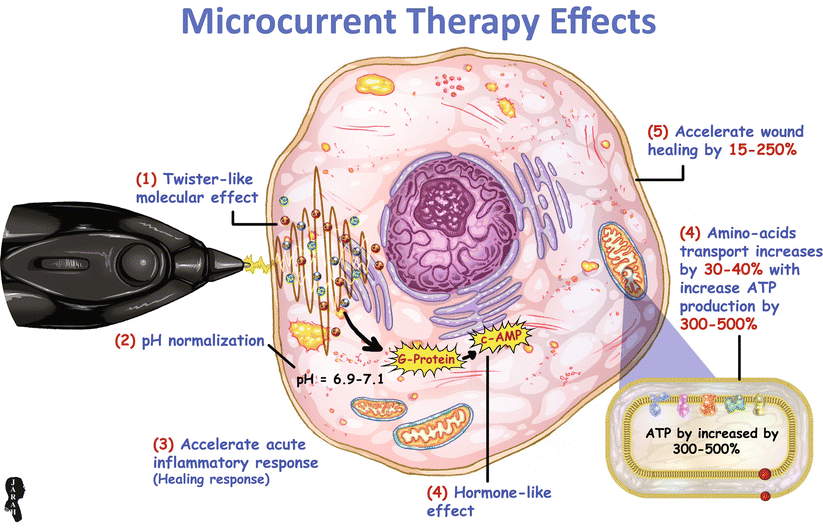
Fig. 14.1.3
An illustration that demonstrates the metabolic effects of microcurrent therapy
- 3.
pH normalization: it is well known that acidity causes pain by evoking the C-fibers and the Aδ fibers in the extracellular matrix. Microcurrents, like any electrical current, are associated with electromagnetic field; this electromagnetic field exerts a direct effect on charged molecules like hydrogen protons (H+), causing their redistribution (diffusion) from their area of high concentration distributing them almost equally through the injured tissue, normalizing their pH effect (Fig. 14.1.3).
- 4.
Hormonelike effect: microcurrents have been proven to exert “hormonelike effects” via electrical activation of the “cell membrane G protein” (Fig. 14.1.3) that will influence the formation of the second messenger cyclic adenosine monophosphate (cAMP), which in turn has a direct effect on cell-specific activities, including cellular repair processes. cAMP is the second messenger created during hormone stimulation, which causes opening of the voltage-gated channels in the Aδ and C-fiber neurons, causing washing out of their wastes products, causing analgesia.
- 5.
Metabolic challenge: microcurrents cause repeated cell membrane depolarization activity, which requires subsequent membrane repolarization; this requires additional energy ATP production, increasing the cellular metabolism to meet the new demand.
- 6.
ATP replenishment: the energy used by human cells requires the hydrolysis of 200–300 mol of ATP everyday. Thus, each ATP molecule is recycled 2000–3000 times during a single day. Since ATP can’t be stored, then its consumption must closely follow its synthesis.
ATP is created from ADP via two main mechanisms in the cells: phosphorylation (by adding a phosphate group to a protein or a small molecule) and chemiosmosis (via pumping H + within the electron transport chain ATPase in the inner mitochondrial membrane).
In 1983, Cheng et al. showed that microcurrent stimulation increases adenosine triphosphate (ATP) generation at 500 μA by 500 % and increases amino acid transport by 30–40 % above control levels (Fig. 14.1.3). Also, another study showed that microcurrent stimulation between 300 and 700 μA increases wound healing by 150–250 % when used as 2-h session per day for 6 weeks.
Microcurrents are believed to increase ATP synthesis via electrolysis of water within the body at the positive electrode (anode), which will migrate through the cell into the mitochondria, used as a substrate to generate ATP via chemiosmosis. The abundance of ATP within the cells will result in muscle contraction, protein biosynthesis, nerve transmission, and active transport of wastes and substrates across the cellular membrane.
Microcurrent Healing Cases
The author has been using quantum therapies for private use and on a narrow scale on patients in the hospital for the past 3 years, using microcurrent devices, pulsed electromagnetic field devices, ultrasonic devices, and phototherapeutic devices. For microcurrent therapy, the author uses the Tennant’s Biomodulator®, the Dolphin Neurostim®, and the Acutron®.
My aim in this chapter is to present to the clinicians reading these pages a relatively new kind of therapy that has been approved worldwide, but still its uses are limited due to the technicality of the devices, ignorance of their existence, plus the cost sometimes. I sincerely hope that in the future, quantum medicine thrives and it takes its proper place in the hospitals and medical clinics.
Case 1
A 62-year-old female patient with “trigger finger,” also known as sclerosing tenosynovitis, was treated with microcurrent therapy. Sclerosing tenosynovitis typically arises due to reduction in the formation of the lubricating synovial fluid around the tendons, causing continuous friction between the tendon and its sheath, which will eventually cause adhesions and limited movement.
Microcurrents cause vasodilation in the treated region; providing heat is a common practice in osteoarthritis and frozen shoulder cases (adhesive capsulitis) because heat causes vasodilation, which will increase oxygen and nutrient delivery to the diseased area assisting in accelerating healing process.
In Fig. 14.1.4, the patient was treated within 5 min by microcurrents (Dolphin Neurostim®), which caused marked gush of blood at the treated region in the thermal images (hyperemia) and resolution of the mild cyanosis seen at the middle finger (arrows and arrowheads) prior to the therapy session.


Fig. 14.1.4




Thermogenic and photographic images of a patient treated with microcurrent therapy for trigger finger (Read the text for details)
Stay updated, free articles. Join our Telegram channel

Full access? Get Clinical Tree



